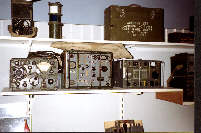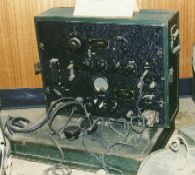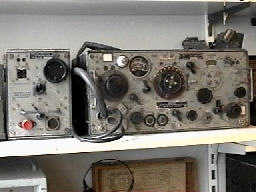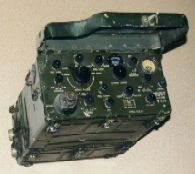| Year of issue | 1943 | |
| Purpose | Rear link L of C Airborne/Truck | |
| Frequency | 2-12 MHz | |
| Range (miles) | CW 300 | |
| Power output (watt) | CW 9 | |
| Transport | Vehicle, parachute, man-pack | |
| Remarks |

The WS-76 is a transportable station for CW communication over long distances. Most times it was used with Reception set R-109, and at the end of the war also with the R-209. The combination 76/109 was used by the Phantom for direct reports to the War Office and by BBC war correspondents.
|
 |
Back to index
| Year of issue | 1945 | |
| Purpose | Infantry Coy Pl | |
| Frequency | 2.960-9.575 MHz | |
| Range (miles) | R/T 3 | |
| Power output (watt) | R/T 0.4 | |
| Transport | Man-pack | |
| Remarks | Crystal controlled, abandoned |
Back to index
| Year of issue | 1948 | |
| Purpose | VHF Radio relay Div and Corps | |
| Frequency | 50-100 Mhz | |
| Range (miles) | R/T 20-30 | |
| Power output (watt) | R/T 18-38 HP, 4-10 LP | |
| Transport | Vehicle | |
| Remarks | After the war renamed C41/R222 |
Back to index
| Year of issue | 1946 | |
| Purpose | Infantry Coy Pl | |
| Frequency | 38.01-39.7 MHz (A) 40.2-42.15 MHz (B) |
|
| Range (miles) | R/T 1 | |
| Power output (watt) | R/T 0.25 | |
| Transport | Man-pack | |
| Remarks | Crystal controlled |
Back to index
| Year of issue | 1949 | |
| Purpose | Infantry Coy Batt RA regt | |
| Frequency | 6-9 MHz | |
| Range (miles) | R/T 5 | |
| Power output (watt) | R/T 0.3 | |
| Transport | Man-pack | |
| Remarks | Canadian design |
Back to index
The Wireless Set No.101 was the most widely used ground and
vehicular set in the early part of World War II and provided most
of the communications in the North African and Middle East
campaigns. A range of up to 9 miles could be archived with voice
using a 9 ft. vertical aerial and much greater distances using
larger aerials and morse. It was manufactured by Amalgamated
Wireless (Australaisa) Ltd. (A.W.A.) in Sydney. Developed in
1939, the No.101 was physically based on the British Wireless Set
No.1 of 1931 with a modern electronic design for the time, and
used through to about 1943. Because of the lack of tropic
proofing, it was found unsatisfactory for use in New Guinea and
the Pacific Islands.
Power source, external 6 volt lead-acid battery. The high tension
is provided by the external vibrator power supply. Frequency
coverage, by master oscillator, 4.28 to 6.66 Mc/s. Output power,
0.75 watts on voice and 1.2 watts on c.w.. Modes, voice (a.m.)
and morse (c.w.). Number of valves, 5 in the receiver and 3 in
the transmitter. The output valves are a pair of 1K5 Parallel.
| Year of issue | 1939 | |
| Purpose | Infantry Brigade /Div & RA regt | |
| Frequency | 4.280-6.660 Mhz | |
| Range (miles) | CW 5, R/T 2 | |
| Power output (watt) | CW 6-12, R/T 4-8 | |
| Transport | Vehicle, ground | |
| Remarks | Australian design |
Back to index
Transmitter, little known. A.W.A.
| Year of issue | ||
| Purpose | ||
| Frequency | 2.5-20 Mhz | |
| Range (miles) | ||
| Power output (watt) | 1 kW | |
| Transport | ||
| Remarks | Australian design |
Back to index
The Wireless Set No.108 was originally developed by Radio
Corporation (Astor) in around 1940 and was the standard manpack
set for providing communications in forward areas during the
Middle East campaign. By late 1941 the Mk.II version with a wider
tuning range, had been introduced and remained the principal
manpack until being replaced in 1946 by the Wireless Set No.128.
Ranges up to 10 miles could be achieved using vertical antennas,
the range largely depending on the type of country.
Power source, internal dry batteries. Frequency control, master
oscillator and four preset channels for the Mks I and II, master
oscillator only for the Mk.III. Output control, approximately 1/4
watt. Modes, voice (a.m.) only for the Mks. I and II, voice
(a.m.) and m.c.w. for the Mk.III. Number of valves, 6.
| Mk I | Mk II | Mk III | |
| Year of issue | 1940 | 1941 | 1943 |
| Purpose | Infantry Battn and coy HQ | Airborne Div, Para Bde, Comb Ops | Airborne Div, Para Bde, Comb Ops |
| Frequency | 8.5-8.9 Mhz | 6-9 MHz | 2.5-3.5 MHz |
| Range (miles) | |||
| Power output (watt) | R/T 0.4 | R/T 0.4 | R/T 0.4, MCW. |
| Transport | Man-pack | Man-pack | Man-pack |
| Remarks | Australian design | Australian design | Australian design |
Back to index
The Wireless Set No.109 was developed by Standard Telephone
and Cables (STC) to provide communications in armoured vehicles,
however it was proved unsuitable for this application and was
relegated to use as a ground or wireless van station. It was
physically based on the British No.9 Wireless Set of 1933 with a
modern electronics for the time. A range of around 15 to 20 miles
with voice and 25 to 30 miles with morse could be archived using
a 9 ft. vertical aerial. Much greater distances could be archived
using larger aerials. As this equipment was not sealed (tropic
proofed), it probably saw little service other than training
purposes from about 1943.
Power source, external 6 volt, 150 Ah. lead-acid battery. High
tension is provided by the external vibrator power supply.
Frequency coverage, by master oscillator, 2.5 to 5 Mc/s. Output
power, approximately 8 watts on c.w. and 4 watts on voice. Modes,
voice (a.m.) and morse (c.w.). Number of valves, 5 in the
receiver and 3 in the transmitter. The output valve is a 4307-A.
| Year of issue | 1943 |  Tony Bell Collection |
| Purpose | ||
| Frequency | 2.5-5 MHz | |
| Range (miles) | CW 25-35, R/T 15-25 | |
| Power output (watt) | CW 8, R/T 4 | |
| Transport | ||
| Remarks | Australian design, based on WS9 |
Back to index
| Year of issue | ||
| Purpose | Army version of the AT5/AR8 | |
| Frequency | ||
| Range (miles) | ||
| Power output (watt) | ||
| Transport | ||
| Remarks | Australian design, by A.W.A. |
Back to index
| Year of issue | ||
| Purpose | Army version of the ATR4A | |
| Frequency | ||
| Range (miles) | ||
| Power output (watt) | ||
| Transport | ||
| Remarks | Australian design, by Radio Corp. |
Back to index
| Year of issue | ||
| Purpose | Army version of the ATR2C | |
| Frequency | ||
| Range (miles) | ||
| Power output (watt) | ||
| Transport | ||
| Remarks | Australian design, by Radio Corp. |
Back to index
Version of No.22 (Aust.) with xtal lock facility,Radio Corp.
| Year of issue | 1945 |  |
| Purpose | GP Bde, Div truck/ground station | |
| Frequency | 2-8 MHz | |
| Range (miles) | CW 15, R/T 10 | |
| Power output (watt) | CW 1.5, R/T 1 | |
| Transport | Truck, man-pack, animal pack | |
| Remarks | Australian |
Back to index
In 1952, probably due to the Korean War, Australia decided to
rebuild the Wireless set No.122 (and probably the No.22 (Aust.)).
Besides the addition of the power connector facilitate the use of
the Amplifier, R.F. No.2 Mk.II (Aust.)/2 for the Wireless Station
No.122 Mk.II H.P., other changes were probably to replace the
capacitors. Ranges from 3 to 5 miles in jungle using a 12 ft.
vertical aerial on voice (a.m.), to 500 miles using a 1/4 wave
aerial and sky wave propagation on morse (c.w.) could be archived
with this general purpose man-transportable, ground or vehicular
set. It remained in service until replaced by the Lackspur
equipment in the late 1950s or early 1960s. The No.122 Mk.II was
rebuilt by Radio Corporation (Astor) in Melbourne.
Power source, external vibrator power supply requiring a 12 volt
lead-acid battery. Frequency coverage, 2 to 8 Mc/s in two
switched bands. Power output, high power, 3.5 to 4 watts on voice
and m.c.w., 6 to 7 watts on c.w., low power, approximately 25% of
high power. Modes, voice (a.m.) and morse (c.w. and m.c.w.). The
receiver is of a 7 valve superhetrodyne design with an
intermediate frequency (IF) of 455 Kc/s. Total number of valves,
10 shared between the transmitter and the receiver. The output
valve is the ubiquitous 807.
|
Back to index
Perhaps through the requirements of signallers in the Korean War and/or through the success of the British Wireless Set No.19 H.P., Australia decided in 1952 to produce a high power version of the Wireless Station No. 122 Mk.II by adding the amplifier, R.F. No.2 Mk.II (Aust.)/2. This equipment was mounted in a Wireless Truck or as a ground station. The Wireless Station No.122 Mk.II H.P. remained in service until replaced by the Lackspur equipment in the late 1950s or early 1960s.
| Year of issue | 1952 | |
| Purpose | GP Bde, Div truck/ground | |
| Frequency | 2-8 MHz | |
| Range (miles) | CW 40, R/T 25 | |
| Power output (watt) | CW 6-7, R/T & MCW 3,5-4 | |
| Transport | Truck, ground station | |
| Remarks |
Back to index
The principal Australian manpack during the New Guinea
campaign, the No.108, had similar problems to most of the types
of wireless sets in that not being sealed, tropical moisture soon
made the sets inoperative and required considerable manpower to
dry the sets. As a part of the Australian policy to have a
complete inventory of sealed sets, design of the second
Australian generation manpack, the Wireless Set No.128, commenced
in 1944 and was approved for production in July 1945. With the
end of World War II in august 1945, the urgency for the set no
longer existed and it did not enter service until 1946. The
No.128 was the main Australian manpack during the Korean War and
was supplemented by the upgraded version, the Wireless Station
No.128 Mk.II in 1952. These sets remained in service until
progressively replaced by the Wireless Station A510 from 1955.
Ranges of 4 to 5 miles in open ground and 2 to 3 miles over
wooded or hilly ground could be archived using an 8 ft. vertical
aerial. Much longer distances could be archived using wire
aerials. The No.128 was manufactured by Tasma Radio (Thorn and
Smith) in Sydney.
Power source, internal 3 and 162 volt dry battery or an
alternative vibrator power supply could be clipped to the bottom
of the set in lieu of the battery box, thus allowing the set to
be powered by an external 6 volt lead-acid battery. Frequency
coverage, 2.0 to 4.5 Mc/s with facilities for master oscillator
and 3 crystal locked channel operation.Power output,
approximately 1/4 watt. Modes, voice (a.m.) and morse (c.w. and
m.c.w.). The receiver is of a superhetrodyne design with an
intermediate frequency of 1.6 Mc/s. Number of valves, 9 miniature
(B7G) shared between the transmitter and receiver. The output
valve is a 3A4.
| Year of issue | 1946 | |
| Purpose | Infantry Coy Battn HQ | |
| Frequency | 2-4.5 Mc/s | |
| Range (miles) | 2-5 miles | |
| Power output (watt) | 0.25 watt | |
| Transport | Man-pack | |
| Remarks | Australian design |
Back to index
Probably due to the Korean War, when it was decided to produce
more Wireless Sets No.128 in 1952, a number of modifications were
undertaken by Tasma Radio (Thom & Smith) in Sydney to produce
the Wireless Station No.128 Mk II. The most significant of these
changes were to use an improved type of connector for the
headset, microphone and morse key and a rugged lightweight
handset plus a number of minor changes to the set itself. The
No.128 and No.128 Mk II were the main Australian manpack towards
the end of the Korean War and remained in service until
progressively replaced by the Wireless Station A510 from 1955.
Ranges of 4 to 5 miles in open ground and 2 to 3 miles over
wooded or hilly ground could be archived using an 8 ft. vertical
aerial. Much longer distances could be archive using wire
aerials.
Power source, internal 3 and 162 volt dry battery. Frequency
coverage, 2.0 to 4.5 Mc/s with facilities for master oscillator
and 3 crystal locked channel operation.Power output,
approximately 1/4 watt. Modes, voice (a.m.) and morse (c.w. and
m.c.w.). The receiver is of a superhetrodyne design with an
intermediate frequency of 1.6 Mc/s. Number of valves, 9 miniature
(B7G) shared between the transmitter and receiver. The output
valve is a 3A4.
| Year of issue | 1952 |  Tony Bell Collection |
| Purpose | Infantry Coy Battn HQ | |
| Frequency | 2-4.5 Mc/s | |
| Range (miles) | 2-5 miles | |
| Power output (watt) | 0.25 watt | |
| Transport | Man-pack | |
| Remarks | Australian design |
Back to index
| Year of issue | 1942 | |
| Purpose | GP corps and L of C medium range set | |
| Frequency | initial 1.47-12 MHz later 2.5-20 MHz |
|
| Range (miles) | CW >300, R/T > 300 | |
| Power output (watt) | CW 300, R/T 100 | |
| Transport | Two 15 cwt Trucks | |
| Remarks | Australian design, A.W.A. |
Back to index
Back to index
| Year of issue | ||
| Purpose | ||
| Frequency | ||
| Range (miles) | ||
| Power output (watt) | 500 watt | |
| Transport | ||
| Remarks | Army version of the AT-20. |
Back to index
The Wireless Set No.208 was developed in Australia as a low
power compact set which could provide communications over a
reasonable distance for principally commando and similar units.
The No.208 was developed from the No.108 Wireless Set onmitting
the voice capability, internal battery and whip antenna. The use
of morse (c.w.) only permitted longer distances to be archived
for a given power output. The dry battery was separate from the
set, thus allowing more compact packing and more even load
distribution amongst the soldiers. Long wire antennas were
provided since they could meet the requirements of moderately
long distance. The set was originally developed by Radio
Corporation in Melbourne in 1941, the Mk.II version entering
service in about 1944. It probably saw little service after World
War II.
Power source, external 1.5 and 99 volt dry battery. Frequency
coverage, 1.5 to 3.5 Mc/s. Frequency control, master oscillator.
Output power, approximately 1/4 watt. Modes, morse (c.w.) only.
The receiver is of a superhetrodyne design with a intermediate
frequency (I.F.) of 455 Kc/s. Number of valves, 4 in the receiver
and 2 in the transmitter, all octal based. The output valve is a
1Q5GT.
| Mk I | Mk II | |
| Year of issue | 1941 | 1944 |
| Purpose | Commando forces | Commando forces |
| Frequency | 2.5-3.5 Mc/s | 1.5-3.5 Mc/s |
| Range (miles) | ||
| Power output (watt) | R/T 0.4 | R/T 0.4 |
| Transport | Man-pack | Man-pack |
| Remarks |
Back to index